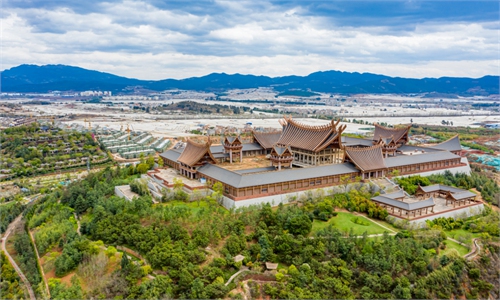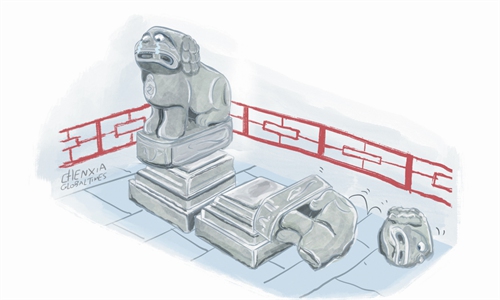With the concept that "cultural heritage is the shared wealth of all humanity and belongs to all people" increasingly spreading and taking root in China, the country's laws and regulations on cultural heritage protection are increasing their focus on ensuring people' cultural rights and encouraging public participation as a fundamental principle. Currently, the involvement of social forces in the protection of cultural relics has made definite progress. This article reviews the various participating entities, objects of participation, and levels of involvement. Through the introduction of cases from Shanxi Province, Beijing and other regions, it summarizes the current pathways of social forces' involvement in cultural heritage protection and the lessons learned from such efforts.

Illustration: Liu Xiangya/GT
With economic development and improvements in living standards, cultural relic protection is no longer an exclusive activity carried out solely by the government or experts. Various social forces are increasingly willing and capable of participating. The scope, degree, methods, and models of participation have expanded and innovated, and their impact and influence have grown correspondingly.
Encouraging social forces to participate in cultural relic protection is one of the effective ways to address challenges in this field, and has become a widely recognized social consensus.
At present, the participation of social forces in cultural relic protection has made progress in terms of participating entities, protected objects, pathways, and levels of involvement. Certain experiences have been gained, but there are also issues that need to be addressed.
Participating entities and protected objects
Among the most active social forces in cultural heritage protection, there are four main categories: social organizations, enterprises, research institutions, and individuals. The most typical social forces are social organizations, which can be roughly divided into two types.
The first type includes organizations with government backgrounds or domestic branches of international NGOs. Examples include the International Council on Monuments and Sites (ICOMOS) China, and the Chinese Society of Cultural Relics.
These organizations typically have greater influence, stronger discourse power, and more abundant funding. The second type consists of grassroot, self-organized civil groups which include formally registered institutions and temporary, unregistered groups.
Apart from social organizations, more and more enterprises, as social forces with strong financial capabilities, are applying the "Internet plus Corporate Social Responsibility (CSR)" model to the field of heritage protection in the internet era, making them an indispensable part of social forces. In addition, individuals play an important role, participating as experts in decision-making, volunteers, amateur protectors, enthusiasts, local residents, or ordinary tourists.
In terms of the cultural heritage objects targeted by social participation, these range from the highest levels, such as World Heritage Sites and national key protected cultural relic units, to lower-level municipal and county cultural relics protection units and ungraded relics.
For lower-level cultural relic protection units, in addition to multi-party cooperation, there are cases where social forces independently lead the protection process.
Pathways for social forces' participation
According to classifications in industry guidelines such as the Principles for the Conservation of Heritage Sites in China, narrowly defined cultural heritage protection work can be divided into three stages: survey and research, protection implementation, and monitoring and management. Based on this framework, the pathways for social forces' participation in cultural heritage protection can be analyzed across three main areas.
Participation in preliminary surveys and research is a form of participation with relatively low thresholds and difficulty levels. By contributing time and manpower, social forces help alleviate the shortage of professional personnel in cultural relic protection and management. Personal involvement effectively cultivates public awareness of heritage protection and enhances regional cultural confidence.
Social forces' participation in preliminary surveys can assist cultural relic management departments in getting a clear picture of cultural relics, clarifying the quantity, preservation status, and basic information of various relics, and laying a foundation for the formulation of specific policies.
One example is the campaign of exploring and investigating old streets to protect cultural relics in Southwest China's Chongqing Municipality, which started in 2018. It has attracted numerous volunteers, with over 300 sessions held and a total participation exceeding 13,000 people. This campaign has encompassed 177 cultural heritage sites in Chongqing. The campaign has yielded significant results, discovering 20 cultural relics protection units previously overlooked by the government.
During the protection intervention or project implementation stage, social forces in China mainly participate through financial contributions. The common model involves foundations raising funds from social groups, enterprises, or individuals. Additionally, enterprises and individuals make certain attempts and explorations to directly connect with protection projects.
In the post-protection stage, social forces actively participate in monitoring and management. On the one hand, provinces like Gansu, Qinghai, Shanxi, Henan, and Sichuan have widely implemented systems for cultural relic caretakers, cultural relic protectors, or cultural relic patrol guards, providing salaries to unemployed residents in villages and towns. These systems play a significant role in protecting and monitoring relics in rural areas.
On the other hand, the development of online platforms in the information age supports social organizations or volunteers in effectively assisting with relics management and law enforcement in handling cultural relic violations.
For example, the "Take a Photo of the Great Wall" activity organized by volunteer groups in Beijing has become a regular, organized means of supervision with established channels for cultural relic protection in Beijing. According to incomplete statistics from China's National Cultural Heritage Administration, nearly 80 percent of cultural relic violation cases in the past five years stemmed from reports from social organizations, the public and media disclosures, demonstrating the significant strength of social forces.
After decades of development, the level of social forces' participation in heritage protection in China now includes four stages: awareness, understanding, involvement, and influence. In terms of professional work in heritage protection, social forces have penetrated into the stages of involvement and influence.
The achievements so far include the preliminary establishment of policy and institutional systems, beneficial exploration of participation pathways, gradual accumulation of participation experience, making social forces a strong complement to the government. This is reflected in the further improvement of policies and regulations, the securing of funds for cultural relic protection, and the enhancement of public participation and responsibility.
The author is an associate professor at the School of Architecture and a senior engineer at the National Heritage Center of Tsinghua University



